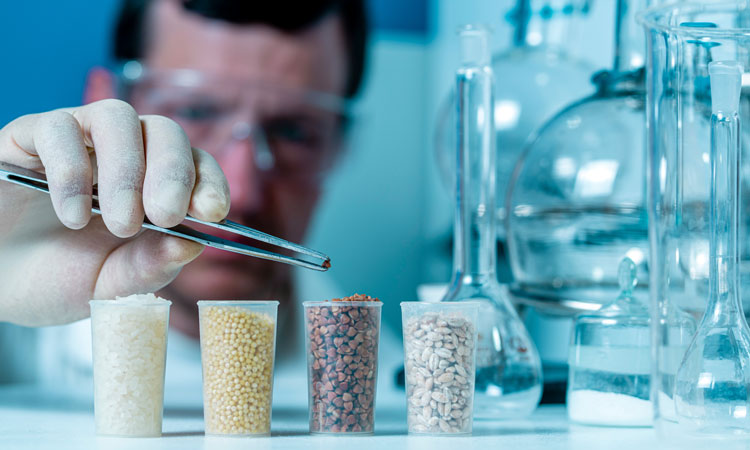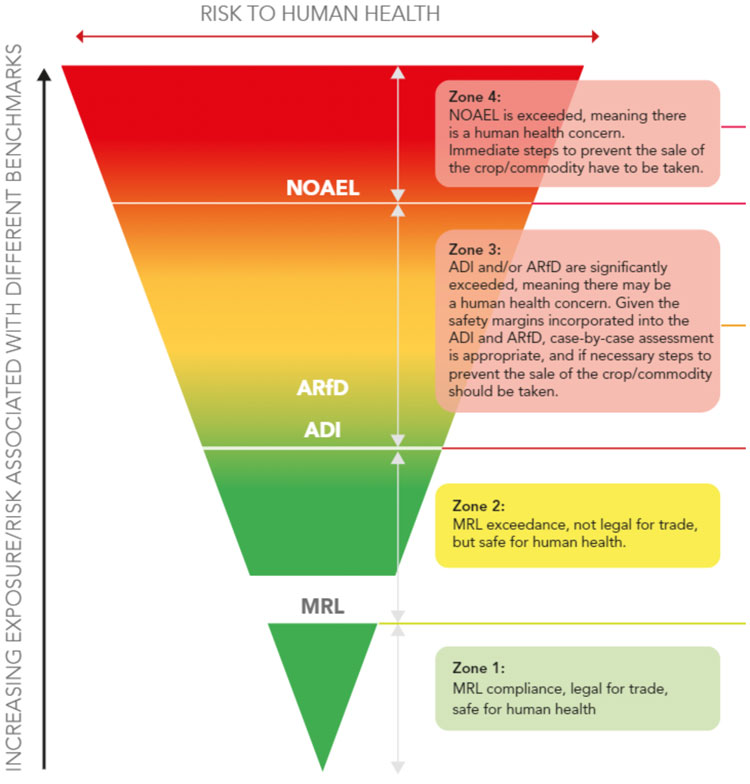Pesticides: why, how and what?
- Like
- Digg
- Del
- Tumblr
- VKontakte
- Buffer
- Love This
- Odnoklassniki
- Meneame
- Blogger
- Amazon
- Yahoo Mail
- Gmail
- AOL
- Newsvine
- HackerNews
- Evernote
- MySpace
- Mail.ru
- Viadeo
- Line
- Comments
- Yummly
- SMS
- Viber
- Telegram
- Subscribe
- Skype
- Facebook Messenger
- Kakao
- LiveJournal
- Yammer
- Edgar
- Fintel
- Mix
- Instapaper
- Copy Link
Posted: 14 January 2022 | Buddhi Dias | No comments yet
Is it a legal requirement, public safety or public perception? In this article, Buddhi Dias tackles the common reasons for testing food for pesticides, as well as what you should expect from a testing laboratory.


If you ask your friends what is their perception of pesticides, what would be the top answers? Most likely: poisonous, cancer-causing, bee killers. All of these have been in media headlines in one form or the other; and as much as there is some truth for using those terms, we still rely heavily on pesticides.
Global demand for food is ever increasing, with more and more of us changing our lifestyles and choices of food. Currently, half of all habitable land is used for agriculture.1
To feed the ever-growing global populations, the yield of food production must be sustained and increased. Technology around farming is evolving to be able to give better yield, but in terms of delivering on sustainability and affordability, there’s still a way to go. Consequently, we still rely on old agricultural techniques, such as use of pesticides and crop rotation to increase and sustain crop yield. Pesticides are used for crop protection to avoid diseases, unwanted vegetation and pests. It is also used in the storage and transportation of fresh produce.
During our client training days, one of the questions often asked by attendees is: ‘Why do we still need pesticides?’ The answer is that pesticides are used to increase crop yield, to keep costs down, and to protect and maintain the appearance of crops. Another reason, which is not always immediately apparent, is that pesticides are used to inhibit the production of natural plant toxins, such as glycoalkaloids, tropane alkaloids and pyrrolizidine alkaloids. In 2019, there were two major food poisoning outbreaks in Uganda that resulted in five deaths and hundreds of people being admitted to hospital.2 Testing revealed that the source of this poisoning was from a super cereal which contained tropane alkaloids.2 It has been suggested that without the use of pesticides, the plants will create its own defensive mechanisms to combat pest and diseases, one such mechanism is plant toxins and these toxins can be far more dangerous than pesticides for human consumption, even in small doses.
In summary, we still need pesticides to produce safe, quality food at affordable prices.
How do we make it safe?
We can all agree that pesticides are poisons, so how do we make sure that it is safe for use? The simple answer would be to adhere to maximum residue levels (MRLs). In some form or another, everyone would have come across MRLs; when our clients ask for pesticide testing, many of them will request MRL testing as this is what is legislated, either under EU (European Union) regulations, or as of January 2021, under GB (Great Britain) regulations. These regulations are for any EU countries and GB. It is slightly confusing, however, as there will be different sets of MRLs for different regions of the world. Other than MRLs set by different countries/regions, there are internationally agreed MRLs under CODEX. Therefore, it is always important to recognise where you are selling your product and if the product is legally allowed to be sold under those regulations.
It is easy to think that MRLs, as well as the approval of an active substance that applies to GB should be the same in Peru, for example. However, it is not that straightforward; MRLs or approval of actives are set by data gathered by the pesticide producers. The data is gathered whilst doing field studies in different regions, which can be determined by the weather and soil conditions, as well as many other factors. Therefore, a certain active could be approved for use in Peru and not in GB. In some cases, the MRL would reflect this fact. This is where you have certain actives that are not approved for use, but have a higher set of MRLs.
To establish MRLs, several other factors are considered first. The initial level that is established for an active is what is called the NOAEL (no observed adverse effect level). This is the highest level of pesticides that can be ingested without showing any adverse effects. The next levels are what is used in consumer risk assessments, ADI (acceptable daily intake) and ARfD (acute reference dose) values, which are established by dividing the NOAEL by at least 100.3
ADI is the safe amount of a pesticide that can be ingested every day over an entire lifetime without compromising the health of the consumer. ARfD is the safe amount that can be ingested in a single day without effecting the health of the consumer, which is why these factors are used to calculate the risk factors of finding certain pesticides in products. This is a more beneficial tool when you are dealing with a mixture of commodities.
MRLs are applied to the raw materials, so in order to establish the MRL of a product and grant approval for use, a dietary risk assessment is conducted using ARfD and ADI values. If the MRL values are safe under the worst case scenarios, then the approval is granted and the MRL is established.
The MRLs are recognised as legal trade standards, intended to check if the pesticides have been applied correctly. Therefore, a minor MRL exceedance does not automatically pose a risk to the consumer. It is then pertinent to question why the industry like to see residue levels that are 50 or 30 percent below the MRL. What is the purpose of these limits if there are already established safe limits to the consumer?
Figure 2 is a good illustration of the risk associated with human health and different benchmarks for active ingredients in pesticides.
What to expect from a laboratory
One of the key factors in deciding your testing partner, besides their capabilities, is whether the lab is accredited or not. The fundamental basis on which all the accreditations are carried out is by assessing against the ISO 17025 standards. These standards are set to harmonise all labs across the world. In the UK, the accreditation and assessments are carried out by UKAS. Each country will have its own accreditation body to verify if a lab is carrying out testing according to the ISO standards.
Within the EU, there is an extra guidance document for pesticide testing laboratories to follow. SANTE/12682/2019 is a complementary document to the ISO 17025 guidelines which help to provide harmonised, accurate testing methods for labs, as well as ensure the quality and comparability of results across different labs. It is not yet clear if GB will adopt this or will provide its own set of testing guidelines. It is difficult to see the latter happening as SANTE is already a well‑established set of guidelines.


Measuring Residue levels3
SANTE includes guidance from sample preparation, extraction, calibration, instrument calibration, confirmation of results to commodity groups, and also provides a default measurement of uncertainty (MU) for detected pesticides as ±50 percent. To use this value by a laboratory, they must demonstrate that its own expanded MU is below 50 percent. This value is also recommended to use by regulatory authorities when they are enforcing MRL exceedances.
Most, if not all labs, will be using the well-established QuEChERs (quick, easy, cheap, effective, rugged and safe) method for pesticide extraction, whether it is the EN method or the AOAC method. Either way, they all have the sample principle.
QuEChERs has revolutionised how pesticides have been tested. Prior to this, individual sample types had individual testing methods and used high toxicity solvents in larger volumes. Also, the number of actives previously screened was far less. With the introduction of QuEChERs, the extraction of multiple different sample types using one extraction and safer solvents in smaller quantities is possible – this is also cheaper.
Before the extraction can take place, samples are homogenised down to either a fine powder or a smooth paste. It is important that representative samples are submitted to the lab and the minimum weight guidelines are followed according to 2002/63/EC. In the lab, it is also essential to take the correct portion where MRL is applicable, as well as a representative portion to be homogenised. These steps are vital in obtaining accurate results when using the QuEChERs method.
Essentially QuEChERs can be broken down into two steps. One is extraction and the next is clean up. During the extraction step, the pesticides are removed from the sample into an extract solvent. Then, during the second step, many different interferences are removed; this is then ready to be run on chromatographic systems. Depending on the sample type, the clean up can vary to aid the process. For more complex matrix, such as teas and spices, a more extensive clean up process is carried out compared to that of fruit or vegetables, for example.
The rate determining steps of the process, in terms of releasing results, is the run time on the different chromatographic systems. In pesticides analysis, gas chromatography (GC) and liquid chromatography (LC), coupled with mass spectrometry (MS) are utilised to give quantitate results. A typical runtime for a sample on an LC system can be anywhere between 12 and 15 minutes, whereas on a GC system, it is around 30 minutes. Hence, a lab is limited on how many samples can be tested by the number of GC systems they possess. Similarly, this will also limit how many same day samples can be reported.
Once all the quality control criteria have passed and any MRL exceedances are confirmed by means of repeat analysis, the lab is ready to report the results to the client. If there is an MRL exceedance, it is always good to check with the lab if a repeat analysis has been undertaken, and even better, a second portion from the batch sent before any red buttons are hit.
About the author
After obtaining his MSc from Kings College in London, Buddhi Dias went to work in the analytical chemistry sector, joining ALS in 2017. He now heads the contaminants and pesticides department at ALS, where he is working with an excellent team to provide reliable testing, technical advice and training days.
References
- This data is sourced from the UN Food and Agriculture Organization
- Tropane alkaloid contamination of agricultural commodities and food products in relation to consumer health: Learnings from the 2019 Uganda food aid outbreak – Abia – 2021 – Comprehensive
- Reviews in Food Science and Food Safety – Wiley Online Library
- Pesticide use and food safety, European Crop Protection, May 2014
Issue
Related topics
Food Safety, Health & Nutrition, Pesticides, Quality analysis & quality control (QA/QC), Regulation & Legislation









